My head hurts. There’s this ringing in my ear. I think I’ve developed a Ginseng dependency. Friends and confidants think I’m grappling with a closet heroin addiction, but they’re wrong.
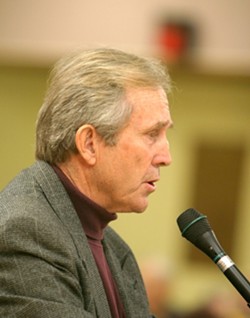
- BARROWING DOWN : Involved Ososite Al Barrow faced an assault allegation by Sam Blakeslee’s office after the activist reportedly unloaded his frustration on a 19-year-old secretary. The young woman said she felt threatened, but a CHP investigation determined that the man posed no threat.
How the hell did these fruit bats get in my cubicle?
For those seeking answers, the 23-year-old saga of the Los Osos sewer debacle is most accurately told through the clusters of malcontents trapped in the now-infamously idiosyncratic berg. Of these, there traditionally existed three sorts. Most obvious is the “egads-I-used-to-be-a-stakeholder-but-now-all-I-can-do-is-endlessly-litigate� malcontent. An astute but casual purveyor might also run upon the shaky-shaky-“the-only-thing-certain-in-life-is-death-taxes-and-Tri-W� malcontent. And the even more attentive Osos-watcher eventually eyes the third lot—certainly my personal favorite—the “my-septic-don’t-pollute-and-to-hell-with-the-elephant-seal-that-oarks-otherwise� malcontent.
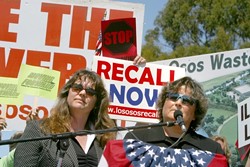
- TWO OPPOSED : Current board members Julie Tacker (left) and Lisa Schicker (right) remain guarded about surrendering project control to the county. Both claim that communication between county staff and the CSD is greatly lacking.
“So,� one may ask, “how did such a simple public-works project manage to get so convoluted?� Good people,
I’ll attempt to explain. No, there is too much. I’ll succeed at oversimplifying.
The Los Osos Community Services District formed in 1998 when 87 percent of local voters approved Measure K, a backdoor move to abort county engineering’s much-mulled-over sewer project before the California Coastal Commission could raise it from its prenatal fluids. Back then, the contention over the $70-million project proved simple: A sewer meant another lofty bill. Folks feared that the hike would hurl poorer residents out of town. The Regional Water Quality Control Board again trumpeted its already 15-year-old findings on nitrate contamination in the Los Osos groundwater and insisted on prompt construction of the sewer.
Several sewer advocates, known as the Solution Group,
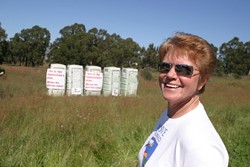
- OUT IN FRONT : Solution Group founder Pandora Nash-Karner spearheaded the campaign to build a treatment facility in the middle of town. She promoted the concept of packaging it with recreational resources, which, naturally, require a centralized location like Tri-W.
Moving such an expensive project past the public no doubt took some doing. Yet, locals attest that Nash-Karner—a marketing professional—could sell morality to a tobacco company boardroom. She formulated a campaign promoting the new plan as “Cheaper, better, and faster.� Despite the extremely unpopular location, upwind of most of the community, the agencies hopped on the bandwagon—something certain officials still regret.
Again, the town exploded in outrage, but the CSD board, facing the threat of further fines by the water board and the insolvency they expedited, forged onward. An angered citizenry recalled several of the CSD board members in September, but not before they managed to break ground on the controversial project. With a new board at the helm—still largely treading water, struggling to keep the CSD afloat—Blakeslee stepped in with a plan to transfer control to the county in exchange for a few economic assurances. The assemblyman built AB2701 upon an infrastructure of presumed cooperation between county staff and the CSD, and also on the assumption that voters would approve certain ballot items—now required under Proposition 218—needed to fund the project.
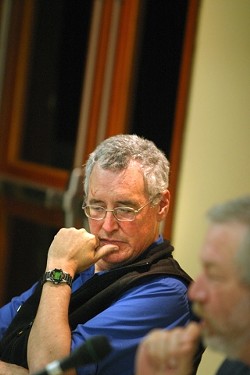
- BRUCE ALMIGHTY : Former CSD general manager Bruce Buel shouldered much of the malaise over Tri-W. He promptly made tracks for Nipomo after the recall.
Because the former incarnation of the CSD forged ahead and accepted ludicrously high construction contracts to break ground in the shadow of a recall, $6.4 million of the State Revolving Fund (SRF) loan granted by the California water board swirled down the crapper. That’s seven figures of taxpayer loan money, up to this point, poofed away—a phenomenon the private sector sometimes calls defaulting. However, Sacramento is yet to repossess the town of Los Osos. By the way, the state water board reports that interest on the due loan amount is still accruing.
Blakeslee took a huge step forward in presenting a solution for the entire county. The Ripley Pacific team went farther by laying out tangible options for Los Osos in a July 7 solutions meeting. Still, it takes more than a mere lack of planning to delay a sewer by a quarter century. The sociopolitical topsoil remains infertile—several more advancements must occur to keep this plan from coming out the other end.
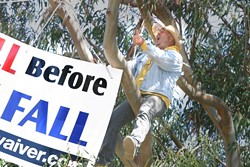
- KID IN A TREE : Resident Joey Racano, the self-styled “Los Osos Kid,� threw a shit fit when the project flushed several of his furry friends off the lot at Tri-W. He staged a month-long protest leading up to the September recall.
to allow good ideas—like the effluent alternative to the gravity collection
system—to erode in the bureaucratic mix. Schicker stated that the board plans to
discuss this matter, along with the hot topic of Tri-W, once these meetings between the two essential stakeholders commence.
CSD director Julie Tacker recently alluded to a still publicly unreleased study that may indicate that the infamous upper aquifer of the Los Osos groundwater table is relatively clean. That is, of course, other than the nitrates, which can be filtered out of tap water. If verified, this means the foul groundwater that sent the regional board into a fining frenzy could conceivably be suitable for human consumption. When New Times approached county staff about it, a frightening silence captured the receiver. Folks—it’s time to pow-wow.
Speaking of phantom studies, what’s up with the water board disregarding a 1987 isotope study by Dr. Roy Spalding (see “Chemical balk,� page 4) that reportedly called into question the very source of the nitrates? Cal Poly soil sciences professor Tom Ruehr reported that water board staff, once upon a time, pushed this inconvenient truth aside and kept it marginalized to this day. Apparently agencies possess the power to disregard science that disagrees with its decisions. My grandfather might comment that somebody over there is full of blue mud—whatever that meant, anyway. Is nitrate blue?
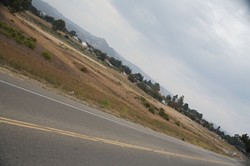
- TAKE A BIG WHIFF : The controversial Tri-W site for the proposed sewer-treatment facility created public outrage because of its proximity to several neighborhoods. A vibrant open space once existed where a fence now guards an empty hole.
For example, the new CSD wisely decided not to accept a pre-existing candidate site study as gospel and hired Ripley Pacific to draft another. That study revealed a drastically different perspective of the once-favored Tri-W (see “Ripley’s believe it or not,� June 13). Tri-W came in dead last in the 16-point review. The situation definitely calls for further study of the candidates, but—for sanity’s sake—it’s time to strike Tri-W from the list and save the body politic in San Luis Obispo County a collective aneurism.
When the same site can top one analysis and cellar-out in another, and the public repeatedly and clearly testifies that it doesn’t want a shit factory downtown, then the need exists to reexamine what tidbits earn the distinction of truth. A logical review indicates that, to bypass overwhelming public opinion, indisputable evidence must exhibit the functional value of the maligned incumbent. This situation, however, reeks of scientific bias.
In light of this new information and recognizing the pressing need for cooperation in order to curb another collapse, involved parties must first calm the town’s turbulent waters. Start by staying the fines and scrapping all cease-and-desist orders—two items California regulators might perceive as signaling Armageddon. Also, allow the CSD to sell Tri-W and recoup that $7.6 million. Blakeslee’s office responded to the latter proposal with a claim that certain parties in Sacramento might gag on a bill loaded with amendments preliminarily eliminating options. That’s a reasonable concern, which brings up a second-to-last talking point:
The Osos must flow. Passion is the town’s blessing, and its curse. The best way to prevent future oversights and ensure transparency is to allow the Ososites—even the ones who perhaps belong in ASH—their due input in the process. The assembly won’t buy site-restrictive amendments? Fine. Send a Sewerville malcontent to shadow every assemblyperson in the state for a day, just so they can see what we’re up against. Rest assured, they’ll get the point quickly enough—potential Eighth Amendment violations aside.
Blakeslee, for obvious reasons, clearly wanted to keep the Ososites as far away from the Senate committee floor as possible to avoid stalling the bill. Some citizens desire unreasonable accommodations, no doubt, and certainly it’s more productive to limit committee testimony to just the meat and potatoes. Yet, when anti-B, anti-recall folks like County Supervisor Shirley Bianchi show up and Blakeslee fails to inform the opposition of a very important public comment session, that’s problematic.
Tacker caught wind of the session anyway and drove up to Sacramento. The director reported, at that committee hearing, that Bianchi likened Los Osos to a dogfight and called the proposed bill “water to fill the county’s fire hose.� Well, anyone who has turned a hose on scrapping feral dogs knows all you get is wet dogs. And rabies.
Finally, it’s time to get to the bottom of this pre-recall State Revolving Funds entanglement, because several potentially guilty parties in that catastrophe also appear partly responsible for delaying the current solution. Of all the numbers abounding in this sordid affair, only one trend seems unanimously accepted: the rising cost of construction. By the end, this could end up costing 5,000 homes a large fortune or the rest of us a small one.
Board members told local blogger Ann Calhoun that the former CSD paid the contractors sooner than they were legally required to and without properly invoicing the state. New Times later verified that tidbit through official documents. By law, the contractor fees weren’t due until after the recall date. Former CSD co-chair Richard LeGros stated in a letter to the current board that the part of the SRF loan used to repay planning expenses kept the CSD from crashing in 2005. Robbing Peter to pay Paul, so to speak.
From alpha to omega, the sewer saga appears a very murky matter, gravely in need of some subpoena-powered illumination. Certainly if the CSD falls to rack and ruin now, and the sewer situation goes supernova once more, this columnist wants a Grand Jury investigation.
And so should you. ∆
Previously on Osos:
Precall (aired 7/7/05)
The loan check was written, the property purchased. The old Los Osos CSD board had control of the project—for a few more months at least. The options: Delay the construction to allow for discussing the consequences or throw up some fences and bust out the golden shovels. A raucous crowd showed up to protest the ceremonial groundbreaking and two dissenting board members dropped their spades and walked. Regardless, the bulldozers marched on. By year’s end, the recall election gave the CSD a decisively new face and Los Osos voters passed Measure B, an initiative to halt construction. In Sacramento, Barbara Evoy, director of the state body granting the loan, said she never saw anything like it.
Tanks, but no tanks (aired 3/26/06)
Tempers flared when the regional water board drafted cease-and-desist orders against 45 Los Osos properties for nitrate contamination of the town’s groundwater table. Half the town went berserk over a stipulation forcing these prohibition-zone residents to routinely pump their septic tanks—at great cost to individual homeowners. Water board staff later cut the “mad pumping scheme� from the draft but required the LO-45 to grant power of attorney to outside representation in lieu of hiring a lawyer to represent their interests. Of course, most of the LO-45 can’t afford legal representation, ultimately forcing them to abdicate rights in order to oppose the order.
For posterity’s sake (aired 9/22/04)
Remember youth soccer? The fresh grass of a young spring, a golden sun shining upon the pitch, the smell of exposed sewage? Apparently not everyone grew up in Newark. However, future generations of Los Ososites came close to receiving a taste of that Jersey experience, starting in 2004. Then-CSD vice chair Pandora Nash-Karner—also a parks commissioner—mapped a grandiose scheme to fit Tri-W with not only a sewage treatment facility, but also a cacophony of recreational bells and whistles. To serve as a decent park, the plant site required a central location: Tri-W. AM pundit Dave Congalton coined the ill-conceived project “Pandoraland,� and the name stuck.
D’oh. A deer! (aired 9/11/05)
With the recall date quickly approaching, outspoken resident Joey Racano launched a lengthy guerrilla protest campaign against the sitting manifestation of the CSD board. Alleging environmental havoc created by construction at Tri-W, Racano paraded around town with pictures of a dead fawn, which, he claimed, became trapped in the construction fencing and starved to death. The Los Osos resident blamed the CSD for murdering the fawn and many other fuzzy critters with the hasty commencement. “How much notice did these animals receive?� he blogged one day in protest. At least one official suggested that Racano simply pitched some roadkill over the fence.
Don’t call me Shirley (aired 4/29/06)
“It doesn’t pay to try and help people,� Dr. Gonzo concluded in the film adaptation of Fear and Loathing in Las Vegas. Sam Blakeslee learned that truth—or, more accurately, his 19-year-old secretary did—one day when resident Al Barrow came by to exchange words. California Highway Patrol investigators later found threat charges unfounded. County supervisor Shirley Bianchi already knew the politician’s pain all too well—several ranting Los Ososites verbally assaulted her at various board meetings over her opposition to Measure B. Several months later, when townsfolk asked the District 2 supe to speak at a regional water board meeting, she, not surprisingly, declined. ∆
To comment on this Gonzo drek, hit up Staff Writer Patrick M. Klemz at [email protected].
Comments